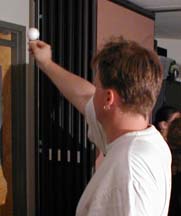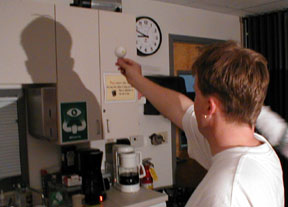First you wax your car then it wains. Tien Huynh-Dinh

Linda Shore teaches about the phases of the moon.
Here she is holding the lghtbulb/sun.
First you wax your car then it wains. Tien Huynh-Dinh

Linda Shore teaches about the phases of the moon.
Here she is holding the lghtbulb/sun.
Introduction
With a white Styrofoam ball and a lamp you an see the phases of the moon.
Material
Assembly
Push the pushpin into the Styrofoam ball.
To Do and Notice
Turn on the lamp. Darken the room.
Hold the Styrofoam ball by its pushpin just to the left side of the line between you and the lamp. Notice that you see an illuminated crescent moon. This is the waxing crescent.
Continue moving the moon around you to the left, counterclockwise viewed from above your head. When it is 90 degrees from the line between you and the lamp notice that half of the moon is illuminated. This is the first quarter moon.
Rotate counterclockwise more. When the moon is opposite the sun it comes within the shadow of your head, this would be a total lunar eclipse. Most months however the moon passes above or below the shadow of the earth and is seen fully illuminated as a full moon.


If the moon is within the shadow of your head you are
modelling a lunar eclipse.
Continue rotating. The moon begins to wain, it becomes half illuminated again at third quarter. Then becomes crescent.
When you reach the line between your eye and the lamp look around at other people, notice that the shadow of the moon falls on their faces. This is a total solar eclipse. Usually the shadow of the moon falls above or below the earth and there is a new moon without an eclipse.

What's Going On?.
Many people think that the moon's phases are caused by the shadow of the earth. Emphasize the difference between the shadow of the moon on itself which causes the phases, and the shadow of the earth on the moon which causes a lunar eclipse.
Etc.
The moon and the sun subtend a half a degree each. The exact match in angular size leads to spectacular solar eclipses. The moon's orbit tilts at an angle of 5 degrees with respect to the plane of the ecliptic, the plane of the earth's orbit about the sun. This means that most of the time the moon passes above or below the sun in the sky.
|
Scientific Explorations with Linda Shore and Paul Doherty |
|
12 July 2001 |